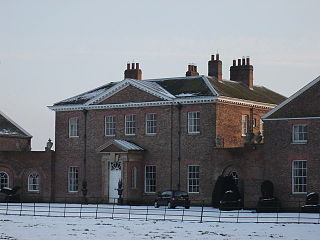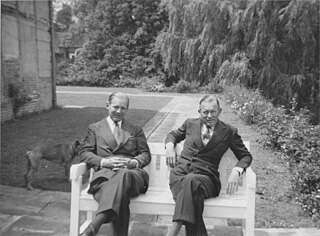
Marmaduke Langdale, 1st Baron Langdale was a landowner and soldier from Yorkshire who fought with the Royalists during the Wars of the Three Kingdoms.

Lord Herries of Terregles is a hereditary title in the Peerage of Scotland. It was created in 1490 for Herbert Herries with remainder to his heirs general.
Henry Edmund FitzAlan-Howard, 2nd Viscount FitzAlan of Derwent, was a British peer.

Stanwick St John is a village, civil parish, former manor and ecclesiastical parish in the Richmondshire district of North Yorkshire,, England. It is situated between the towns of Darlington and Richmond, close to Scotch Corner and the remains of the Roman fort and bridge at Piercebridge.

Holme-on-Spalding-Moor is a large village and civil parish in the East Riding of Yorkshire, England. It is situated approximately 8 miles (13 km) north-east of Howden and 5 miles (8 km) south-west of Market Weighton. It lies on the A163 road where it joins the A614 road.

Allerton Castle, also known as Allerton Park, is a Grade I listed nineteenth-century Gothic or Victorian Gothic house at Allerton Mauleverer in North Yorkshire, England. It was rebuilt by architect George Martin, of Baker Street, London in 1843–53.

Baron Langdale was a title that was created twice in British history. The first creation came in the Peerage of England on 4 February 1658 when the prominent royalist commander of the English Civil War, Sir Marmaduke Langdale, was made by Baron Langdale, of Holme. He had fought alongside Prince Rupert and the Marquess of Newcastle at the Battle of Marston Moor, prior to the war he was the High Sheriff of Yorkshire and in later life a Catholic convert. His son, the second Baron, was Governor of Kingston-upon-Hull. The title descended from father to son until the death of the fifth Baron in 1777. He had no heir as his only son had died as an infant and the title became extinct on his death in 1777. The territorial designation "of Holme" refers to the family's chief seat, Holme Hall in the parish of Holme-on-Spalding-Moor, Yorkshire. The ancient surname of "Langdale" refers to the manor of Langdale in the hundred of Pickering in the County of York which Marmaduke's ancestors held as their seat from before the reign of King John (1199-1216).

Sir Jacob Astley, 1st Baronet of Melton Constable Hall, Norfolk was an English Tory politician and baronet.

Houghton Hall, Sancton, near Market Weighton, is a Grade I listed Georgian country mansion in the East Riding of Yorkshire, England, set in an estate of 7,800 acres (32 km2). Located on the estate is the village of Sancton and the vestigial remains of the ancient hamlet of Houghton. It was built c. 1765–8 by Philip Langdale to the designs of Thomas Atkinson and underwent minor remodelling in 1960 by Francis Johnson. It is built in pink brick with stone dressing and slate roof, with a three-storey, 5-bay main block.

Charles Philip Stourton, 17th Baron Stourton (1752–1816) was the son of William Stourton and Winifred Howard, a great granddaughter of the 6th Duke of Norfolk and a leading Roman Catholic.

William Stourton, 18th Baron Stourton (1776–1846) was a Roman Catholic English peer. He is chiefly remembered for the private memoirs of his relative Maria Fitzherbert, the secret wife of King George IV, which she dictated to him, and which formed the basis for her first biography, published by his brother Charles Langdale in 1856.

Charles Langdale ; 19 September 1787 – 1 December 1868) was a British politician, Roman Catholic layman, and biographer. He served as Whig Member of Parliament, wrote the memoirs of Maria Fitzherbert, and was a leading Roman Catholic figure during the 19th century.

Miles Watson, 2nd Baron Manton (1899–1968),, of Compton Verney, Warwickshire and Plumpton Place, East Sussex, was an English peer and racehorse breeder.

(Joseph) Rupert Eric Robert Watson, 3rd Baron Manton, DL, of Houghton Hall in the parish of Sancton, Yorkshire, was a British soldier, landowner and racehorse owner who served as Senior Steward of the Jockey Club (1982-5).
William Etty was an English architect and craftsman, best known for designing Holy Trinity Church, Leeds and (probably) Holy Trinity Church, Sunderland.
Sir John Bright, 1st Baronet was an English parliamentarian, of Carbrook and Badsworth, Yorkshire.
Sir Robert Tyrwhitt, of Kettleby in Lincolnshire, was an English landowner, politician and administrator whose adherence to Roman Catholicism later led to imprisonment.

Hickleton Hall is a Grade II* listed Georgian stately home in Hickleton, South Yorkshire, England, about 6 miles (10 km) west of Doncaster. For more than 50 years it was a Sue Ryder Care home. It was being converted to luxury apartments, and is now up for sale again.

The Burdett Coutts Memorial Sundial is a structure built in the churchyard of Old St Pancras, London, in 1877–79, at the behest of Baroness Burdett-Coutts. The former churchyard included the burial ground for St Giles-in-the-Fields, where many Catholics and French émigrés were buried. The graveyard closed to burials in 1850, but some graves were disturbed by a cutting of the Midland Railway in 1865 as part of the works to construct its terminus at St Pancras railway station. The churchyard was acquired by the parish authorities in 1875 and reopened as a public park in June 1877. The high Victorian Gothic memorial was built from 1877 and unveiled in 1879. The obelisk acts as a memorial to people buried near the church whose graves were disturbed; the names of over 70 of them are listed on the memorial, including the Chevalier d'Éon, Sir John Soane, John Flaxman, Sir John Gurney, and James Leoni.















